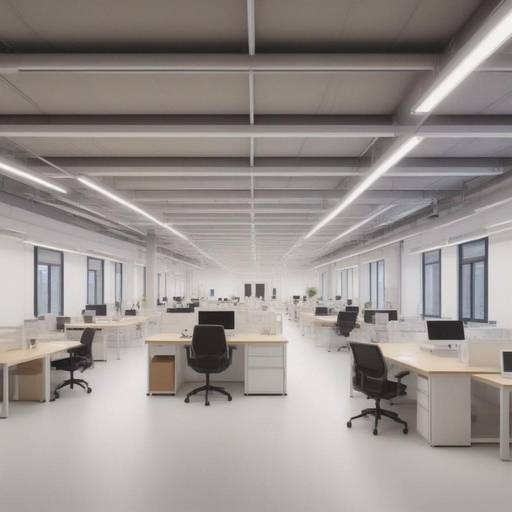
Introduction
At present, the way we work and how we develop in the working environment have undergone significant changes. The design of the workspace has evolved, emphasizing the importance of flexibility to promote labour well-being and increase productivity. In this article we will explore in depth the concept of flexibility in the workplace, its impact on the well-being and productivity of work, as well as future trends in this area.
History and background
The concept of flexibility in the design of the workspace has deep roots that go back to the first labor structures. Throughout history, we have witnessed significant evolution in the way that the working environment is designed and adapted to meet the changing needs of workers.
From the 19th century industrial factories to modern office spaces, the optimization of the working environment has been a central theme. Over the decades, there have been important milestones, such as the introduction of concepts of ergonomics, the emergence of open design offices and the approach of environmental sustainability in the workplace.
In-depth analysis
Flexibility in the design of the workspace involves a number of benefits and challenges. On the one hand, it allows to adapt the working environment to the specific needs of each individual and to foster creativity and collaboration. However, it also poses problems in noise management, privacy and integration of technology.
Studies show that a flexible working environment can contribute significantly to the well-being of employees. The ability to customize space according to individual preferences promotes comfort and reduces stress, which in turn positively affects the mental and physical health of workers.
In terms of productivity, flexibility in the design of the workspace has been revealed as a crucial factor. The possibility of alternating between different configurations of spaces stimulates creativity, concentration and motivation, leading to more efficient and effective work performance.
Comprehensive review
The holistic approach to flexibility in the design of the workspace encompasses numerous applications and best practices. Since the incorporation of rest areas into the application of adaptable technology, there are several strategies that companies can use to optimize the working environment.
Experts in the field of human resources and space design agree that a flexible approach not only improves employee satisfaction, but also increases the retention of talent and the attraction of new professionals. Proactive adaptation to changes in the working environment is essential to ensuring the relevance and competitiveness of companies in the current market.
Comparative analysis
The relationship between spatial flexibility, labour well-being and productivity is intrinsic. The ability to adjust the working environment to the individual needs of employees directly affects their comfort and satisfaction, resulting in greater efficiency and performance in the workplace.
Accessible practical advice and advice
To successfully implement flexibility in the design of the workspace, companies can consider a number of concrete practices. From the creation of collaborative areas to the adoption of adaptable furniture, there are numerous strategies that can maximize the potential of a flexible working environment.
Industry Information and Expert Reviews
Experts in the area of workspace design underscore the importance of continuously adapting working environments to meet the changing needs of the workforce. The ability to anticipate future trends and challenges will enable companies to position themselves in a leading role in the area of flexibility in the workplace.
Case Studies and Applications in Real Life
The successful application of flexibility in the design of the workspace has been manifested through practical cases in various industries and contexts. From innovative technology companies to established organizations, concrete examples demonstrate the positive impact that adaptation of the working environment can have on employee satisfaction and operational efficiency.
Future trends and predictions
The future of the design of the workspace aims at greater integration of flexibility as a central component. Businesses are expected to continue to adopt agile and adaptable approaches to their work structure, which will generate a significant transformation in the dynamics of work and space organization.
Conclusion
Flexibility in the design of the workspace is not only a trend, but a predominant need in the current working environment. The ability to adjust the working environment to the individual needs of employees has a positive impact on the well-being of workers and increases productivity. By adopting a flexible approach, companies can significantly improve the quality of life of their employees, boost innovation and strengthen their competitive market position.
Frequently asked questions
What does flexibility mean in the design of the workspace?
Flexibility in the design of the workspace implies the ability to adapt the working environment to the changing needs of the workers, allowing configurations, furniture and technologies that fit individual tasks and preferences.
How does the flexibility of the workspace influence labour well-being?
The flexibility of the workspace has a positive impact on well-being by offering comfort, reducing stress and promoting an environment that meets the physical and emotional needs of employees.
How does flexibility influence the design of the workspace on labour productivity?
Flexibility in the design of the workspace stimulates the creativity, concentration and motivation of the employees, resulting in greater efficiency and performance.
What are some practical strategies to implement workspace flexibility?
Some strategies include the creation of collaborative areas, the implementation of adaptable furniture, the integration of rest areas and the adoption of flexible technology.
What impact does flexibility have on the design of the workspace on talent retention?
Flexibility in the design of the workspace contributes to employee satisfaction, which in turn strengthens the retention of talent and the ability to attract new professionals.
What are future trends in the design of the workspace in relation to flexibility?
Increased integration of agile and adaptable approaches into the labour structure is expected, which will generate a significant transformation in the dynamics of work and space organization.
Conclusion
In short, flexibility in the design of the workspace is a key aspect of promoting well-being and increasing productivity. By understanding their importance and implementing effective strategies, companies can significantly improve the quality of life of their employees and improve their work performance in a highly competitive environment.






















































